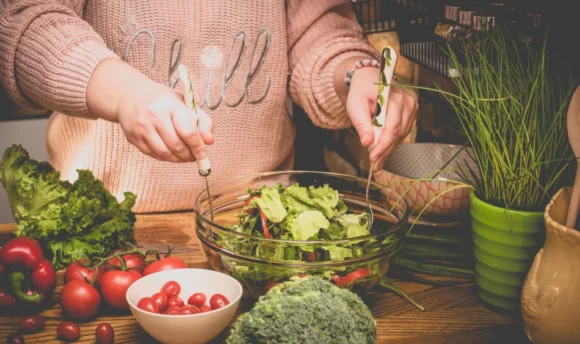Lose 30 Pounds in 30 Days: A Miracle or Death Wish?
We all have different weight loss goals, but the recurring factor is that it’s a struggle, no matter how little or how much you want to lose.

We’d all prefer to lose weight faster than slower, given a choice.
The desire to lose weight is recurrent, whether you want to shed a few excess pounds or reduce your entire body weight.
With so many diets promising rapid results, it’s hard to know which are genuine and safe.
30 pounds in 30 days is an extreme goal to set for yourself. It’s not a smart move, and most experts will advise against it.
The bottom line is if you’re trying to lose weight, your overall health and safety should be the priority.
This article discusses the reality of losing 30 pounds in 30 days and how to start burning body fat quickly.
Can You Lose 30 Pounds in 30 Days?
While it’s not entirely impossible to lose 30 pounds in 30 days, it is illogical, and most people will never succeed with such drastic results.
To lose 30 pounds in 30 days, mathematically speaking, you would have to lose 1 pound each day. That would require massive action through excessive exercise and abrupt changes to your eating habits.
Shedding weight requires you to eat at a calorie deficit, in which you burn more calories than you consume.
One pound of fat is the equivalent of 3,500 calories. So, you will need to burn 3,500 calories every day to meet the requirements.
How many calories a person eats depends on the individual, but the average adult consumes around 2,000–3,000 calories a day. With that number, there aren’t enough calories to physically burn through.
However, it’s possible in the case of a person eating more than 3,500 calories a day to burn this many through intense exercise, several hours a day. For the general population, this is impossible to maintain.
Did you know?
1 out of every 3 American adults suffers from obesity
How Much Weight Can You Lose in a Month?
The CDC and several other sources recommend losing 1–2 pounds per week for steady, healthy weight loss.
That is the number that will keep your body functioning correctly without putting it through unnecessary stress. It’s also the recommended number to prevent you from gaining weight.
Maximum Weight Loss in a Month
With the above information, the maximum weight loss you should aim for to keep health on your side is 5 pounds in a month.
With that in mind, losing 30 pounds would take you roughly between 4 and 7.5 months.
30 pounds is simply too great a number to achieve in just one month.
8 Quickest Ways to Lose 30 Pounds
30 pounds in 30 days isn’t sustainable, but losing 30 pounds in general is.
Start tackling fat fast with our top tips to speed things up.
#1 Intermittent fasting (IF)
Intermittent fasting is an approved method for losing excess pounds. It’s a controlled eating pattern, where you cycle between eating and fasting. You wind up eating fewer calories overall and begin burning through your fat stores. We would recommend starting with a 16/8 IF eating pattern.
There are various ways to do it. Some choose alternate-day fasting, while others eat during a timed period and fast for the rest of the day.
During fasting, you create a metabolic switch. As you starve your body of calories, your body burns through stored glucose and then starts burning fat.
It’s an ancient method that has been modified repeatedly for optimum weight loss results. It’s more approachable than ever, especially as tech experts provide us with supportive tools to get the most out of fasting.
#2 Fewer carbs, more healthy fats
Low-carb diets like the keto diet focus on restricting carb intake and upping the intake of healthy fats. With a carb detox, glucose levels deplete until the body focuses on fueling itself with stored fat. Burning fat equals weight loss.
A high-fat diet is a new concept for many, but it doesn’t mean filling up on junk food. When trying to lose weight, you should always choose nutrient-dense foods over those that bring little value.
The best healthy fat sources are rich in fatty acids and include foods such as:
- Avocado
- Eggs
- Fatty fish
- Olive oil, coconut oil, avocado oil
- Nut butter
- Cheese
- Dark chocolate
With a low-carb diet, you should include a good portion of healthy fat with every meal. The carbs you do eat should be complex carbs. Many plant foods are good sources of complex carbs, such as sweet potatoes, bell peppers, broccoli, and carrots.
Vegetables are a good source of soluble fiber, which makes you feel full while lowering blood sugar and cholesterol levels.
We spoke of the role of technology earlier, and naturally, there’s an app for almost everything. In this instance, the Keto Cycle app is the one to beat.
It works by managing your diet with recipes and accessible ingredients to keep your calorie count on track. It’s a way to balance what you eat throughout the day.
#3 Get active
It’s not all about diet.
It’s one thing to eat healthier, but when you combine diet with exercise, you increase your chances of weight loss.
Exercise is an essential aspect of any weight loss program, as it burns calories. For fat loss, you need to burn more than your calorie intake.
Cardiovascular workouts, high-intensity interval training (HIIT), and strength training will burn calories fast and target stubborn areas like belly fat. They also help maintain lean muscle mass.
But if you’re not prepared for intense exercise, you can try a gentler approach. Did you know walking is an effective activity to lose weight?
#4 Don’t forget to eat protein-rich foods
If you’re hoping to lose 30 pounds, you must increase your protein intake. It’s more filling than carbs and fats, which means you eat fewer calories. It also aids in building and repairing muscle which is fundamental as you increase your workouts.
Get your protein from lean protein, like lean cuts of meat, skinless chicken breast, Greek yogurt, and eggs.
Protein should make up a good part of your plate, alongside good fats.
#5 Avoid sugary drinks
Sugary drinks are nothing but empty calories. While they taste good, they don’t provide any nutritional benefit.
Drinks are often overlooked when calorie counting, but many refreshing liquids have high-calorie content. The extra calories bring nothing to the table other than potential weight gain.
The average can of soda has between 7 and 10 teaspoons of sugar. That’s an alarming number for a single beverage and something to think about when you reach for that can.
It’s not just soda, either. Energy drinks are just as bad, and fruit juice often contains hidden sugars.
Drinking alcohol also puts you at risk of weight gain, as most drinks are high in sugar and calories. Cutting out alcohol is an excellent idea if you’re determined to lose 30 pounds.
Wise up and opt for plain water and low-calorie drinks instead, like unsweetened tea and coffee. Drinking water optimizes weight management, as it tricks your body into feeling full. It takes up space in your stomach, so there’s less room for food.
#6 Watch portion sizes
As well as watching what you eat, you need to watch how much you eat.
Portion control is essential to losing 30 pounds.
When you don’t manage portion sizes, you risk overeating and consuming extra calories that your body will store as fat. Simply put, the more calories on your plate, the more you’re likely to eat.
Removing that risk ensures you only consume what your body physically needs and no more.
#7 Set realistic weight loss goals
30 pounds in 30 days is not a healthy or realistic goal to work toward.
Losing weight is not a particularly enjoyable experience for most, but it doesn’t have to be awful.
Setting realistic goals enables you to focus on progress and build confidence as you reach your benchmarks.
With unrealistic goals, you set yourself up for failure. The stress of an aggressive approach will take its toll on your mental health and leave you feeling exhausted. It’s not sustainable, so why risk it?
Losing 30 pounds in 30 days is extreme. Losing weight rapidly causes all kinds of health problems, such as malnutrition, slow metabolism, and muscle loss.
In the worst cases, severe weight loss can increase the risk of mortality.
#8 Join a support group
Although losing weight is a personal journey, sharing your experience with others can be incredibly useful.
Support groups can help you stay on track, encourage you to keep going, and offer advice and moral support.
Sometimes having a conversation about your efforts can highlight your progress and motivate you to continue, especially as you witness others following the same strategies.
Find a group with like-minded people on a similar journey to your own, whether that’s to lose 30 or 5 pounds.
A Word From RD
Attempting to lose 30 pounds in 30 days is a negative approach and one you should avoid. Various combinations of diet and training make weight loss possible, but it’s the impossible goal that will ruin your efforts.
Instead of harming yourself working toward an unattainable end, set sustainable standards for yourself. You can lose 30 pounds eventually, but it takes time and patience. The gradual approach ensures you don’t gain weight once it’s over, either.
There are several science-backed tactics to shift extra weight: eliminate sugary foods, processed foods, and anything with zero nutritional value. Reduce carbohydrates, and replace them with plenty of protein and healthy fats.
Simultaneously, work out regularly, and include weight training in your schedule.
It’s best not to overlook a healthy sleep schedule. Sleep deprivation messes with the hunger hormones, making you crave the wrong foods and tempting you to overeat.
Try a combination of proven strategies, and you’re sure to see results.
Conclusion
Quite frankly, you should not try to lose 30 pounds in 30 days. It’s simply not feasible unless you’re some superhuman.
Lose 30 pounds the healthier way, with a mindful meal plan, regular physical activity, and a positive attitude toward fat loss. Try intermittent fasting, a tailored low-carb diet, and join forces with other like-minded individuals at a support group to up your game further.

















































 Select your language:
Select your language: 








